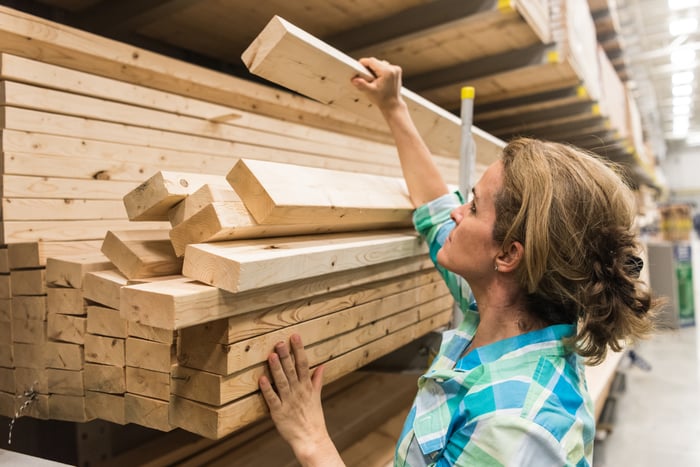As any savvy investor knows, the crucial part of a company's earnings report isn't the historical financial figures -- it's the guidance. Stocks trade on the future, not the past.
This is a major reason why the market was rather cool on Lowe's Companies' (LOW 2.20%) recently released first-quarter earnings report. The company beat analyst estimates on earnings and only slightly missed on revenue, but what it had to say about the coming quarters concerned investors -- and rightly so.
Let's dive in to see what the company had to say.
Slips in the fundamentals
This past Wednesday, Lowe's took the wraps off its inaugural set of quarterly earnings for this year. These revealed that net sales amounted to just over $20.9 billion, representing a 2% slide from the same period in 2024; comparable sales dipped by 1.7%. Net income under GAAP standards also ticked down, landing at $1.64 billion ($2.92 per diluted share) from the year-ago profit of $1.76 billion.

Image source: Getty Images.
On average, analysts following Lowe's fortunes were modeling slightly under $21 billion for the quarter's revenue, and per-share net income of $2.88. They also believed the company would post a slightly steeper decline in same-store sales, specifically by 2.1%.
Interestingly, that dynamic was the opposite for Lowe's arch-rival Home Depot, which reported its own Q1 results the day before -- it beat on revenue but missed on net income. Yet it posted quite the healthy top-line growth figure of 9.5%, and that encouraging number compared to Lowe's 2% drop might have been one reason investors traded the latter down on earnings day.
In the conference call discussing Lowe's results, CEO Marvin Ellison explained that more careful discretionary spending by consumers was dampening results. He also said that ugly weather in various regions around the U.S. had made for a slow start to the spring season -- the time of the year when many people undertake home improvement and gardening projects.
This was mitigated, to a degree, by mid-single-digit growth in the company's Pro offerings for (as the name implies) professionals in the home improvement fields. The catch is, this segment only accounts for about 30% of the company's revenue at present. Online comparable sales, meanwhile, rose at a roughly similar rate.
No massive change expected
Lowe's affirmed its existing guidance for the entirety of 2025, which calls for sales of $83.5 billion to $84.5 billion. That's on comparable sales, which should be flat to 1% higher in comparison to the previous fiscal year. The current consensus analyst estimate of $84.3 billion falls within the proffered range. For comparison's sake, the fiscal 2024 tally was a bit below $83.7 billion.
Anticipated profitability is also more or less in line with pundit projections. Management continues to guide for roughly $12.15 to $12.40 per share for net income, while analysts collectively are modeling $12.21. One major difference to the company's revenue projection is that the bottom-line range is well above the actual year-ago result, which was $8.31.
Yet the tone that investors seemed to be hearing from both the earnings report and the conference call was cautious, edging into negative. Management clearly isn't expecting the current situation to shift -- relatively and persistently high interest rates and macroeconomic uncertainty should keep constricting demand.
In the call, CFO Brandon Sink expressed hope that this would change, stating: "[F]or us, as we look out, we're looking for sustained increase discretionary projects and DIY traffic." However he added: "We don't have that necessarily expected or baked into [2025]. It's sort of expected it's gonna be more of the same at this point."
Seeking other sources of growth
In my opinion, Q1 results for Lowe's mirror those of Home Depot to some extent, in that they reflect good management teams doing the best they can to produce growth in what's essentially a down cycle.
Lowe's earns a few points for going the growth-by-acquisition route in a sensible way, as it announced during the quarter that it agreed to acquire privately held Artisan Design Group (ADG) for just over $1.3 billion.
It described ADG as "a leading nationwide provider of design, distribution and installation services for interior surface finishes, including flooring, cabinets and countertops" serving both home builders and property managers. This, of course, dovetails well with the company's Pro line, and a boost in the take for that segment could certainly help juice the overall fundamentals.
Ultimately, though, I think the downbeat investor reaction to Lowe's latest quarterly performance is justified. The company didn't manage to buck the down trend in its business in the first frame, and like management, I don't see conditions changing much in the coming months. It's hard to get all that excited about home improvement retailers just now, and unfortunately, that includes this one.